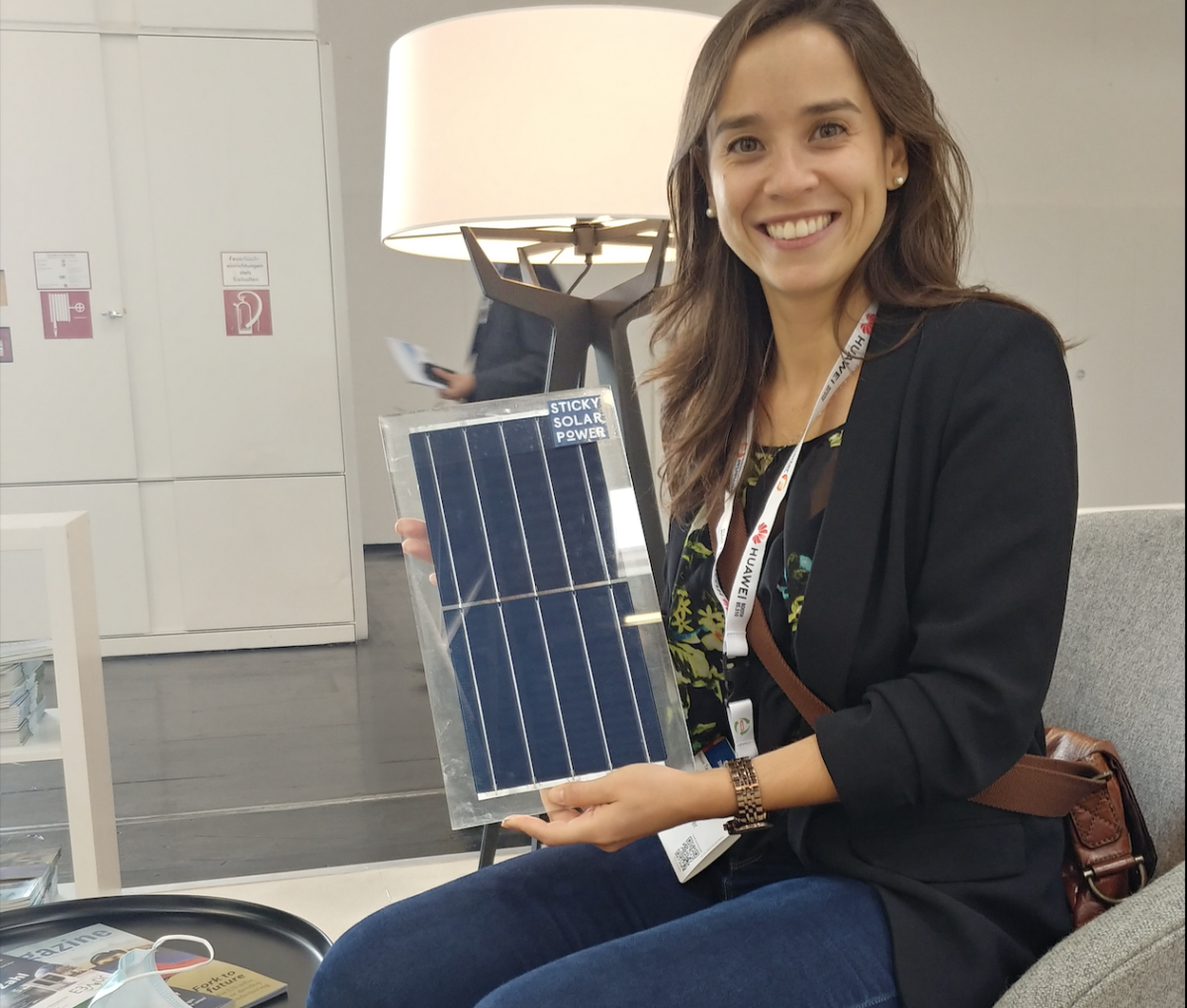Hope for European manufacturers
Despite news of rising PV module prices and delayed solar projects, which came in throughout today, pv magazine’s live blog ends the first day of Intersolar Europe on a high note. Over at the back of hall A5, the mood is positive among European manufacturing equipment suppliers, with the expectation of plenty more capacity to come across the continent in the next few years, and hopes that this could also extend to the U.S.
pv magazine dropped in on German laser experts 3D-Micromac, stringer supplier Teamtechnik, Italian Laminator manufacturer TekniSolar, and a few others, all of whom are expecting strong demand from factories in Europe over the coming years.
Europe’s potential manufacturing comeback is in its early days, however, and it remains to be seen whether the positive atmosphere at today’s show will translate into real projects being built. As Beatriz Roza, CEO at Sticky Solar Power – a Sweden-based company offering a new cell interconnection process based on tape rather than soldering – put it earlier today: “Everyone here is talking about manufacturing in Europe, now we need to do it.”
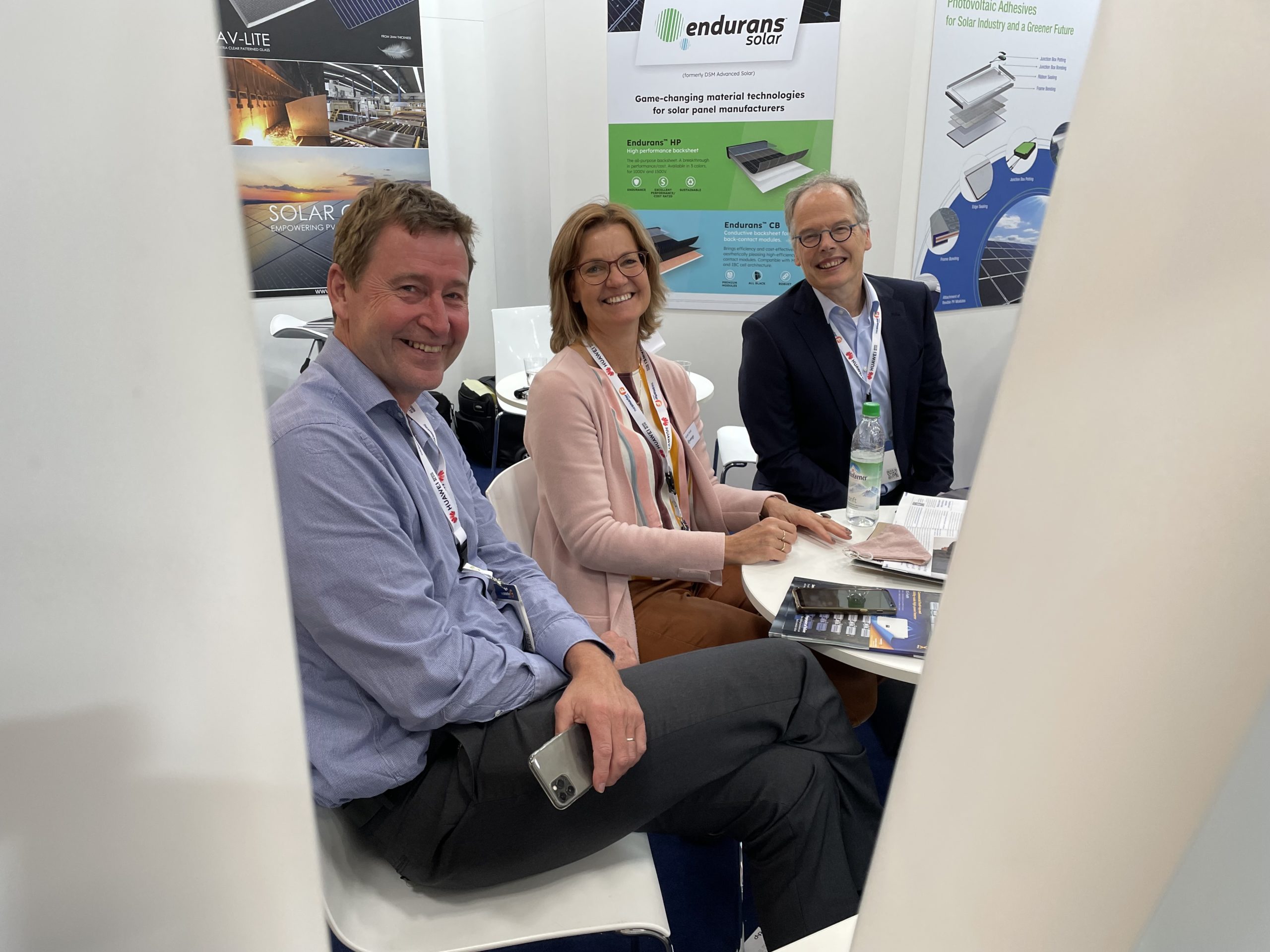
Bringing polymer encapsulants together
A relatively new name in solar materials, Endurans – a spin-off of the solar materials activities of Dutch giant DSM – is continuing to consolidate its PV activities.
Endurans is owned by U.S.-based Worthen Industries, and another of its U.S. subsidiaries, Tomark-Worthen, will now be integrated into Endurans. Still following? In short, the move will bring together the two companies’ module encapsulation product portfolios – including polymer based backsheets and ECA.
“We have everything in our basket, so it will be easier for the manufacturers,” said Annet Hoek, who leads Endurans’ global marketing and communications activities. “In the past if people bought our backhsheets, they would have to go to others for other products [like ECA].”
The decision to bring Tomak-Worthen and Endurans together has only just been made, so there are a lot details to be ironed out, but the intention the bring all the encapsulation is clear.
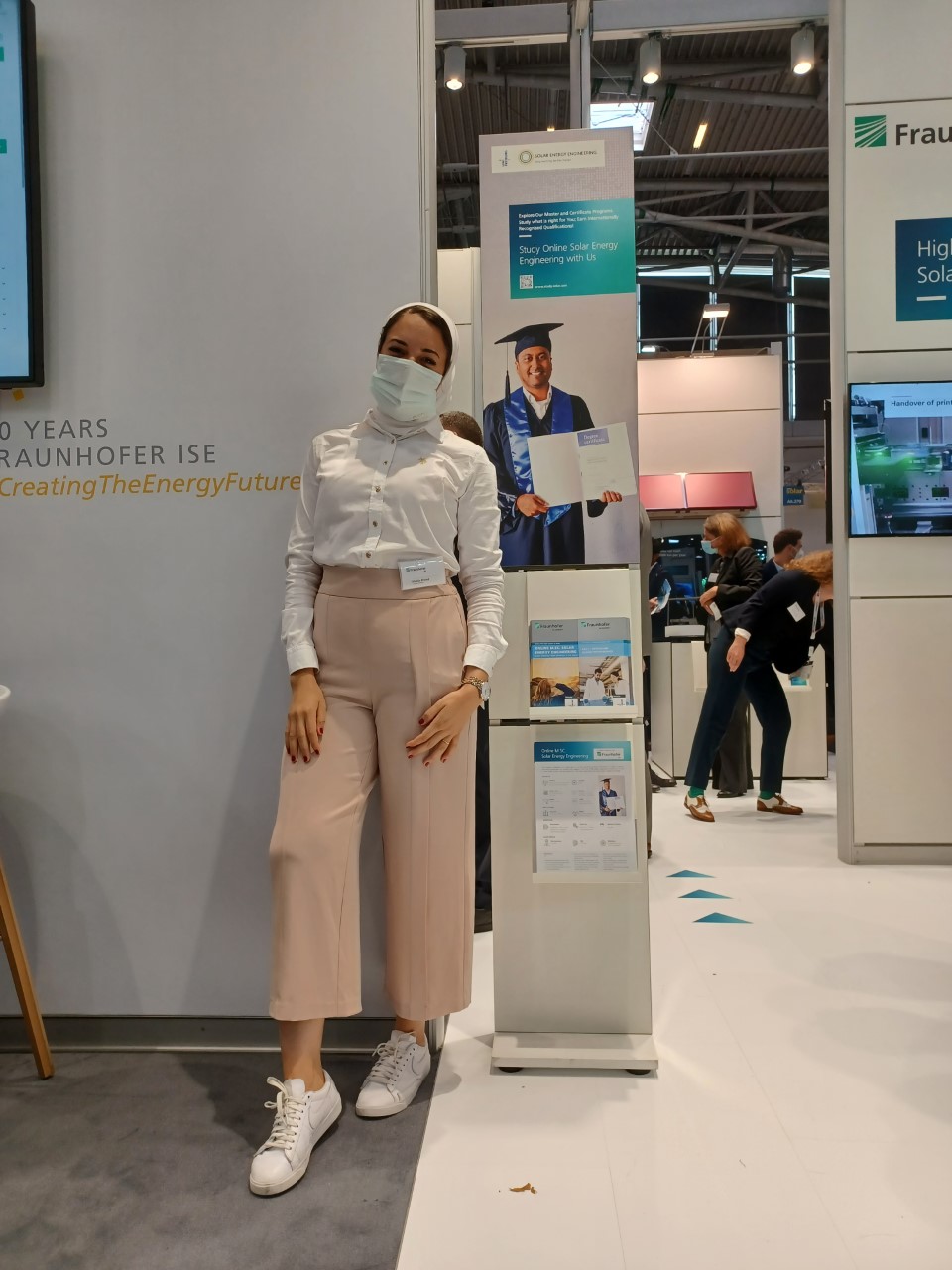
Become brighter by studying solar
As the solar industry continues to expand and incorporate more people from various educational backgrounds, it is interesting to know that there is an academic route for those of us fascinated by harnessing the sun.
Khadija Ahmed (pictured) is an alumnus of the M.SC. in Solar Energy Engineering offered by The Fraunhofer Academy. Ahmed, who wrote her thesis on saving the energy losses incurred on the edges of bifacial p-type Gz-Si PERC shingle cells, told pv magazine the program has in annual intake of 20-25 students with 100 total students at any one time.
The course, offered in combination with Uni Freiburg and can be completed remotely, has been running since 2010.
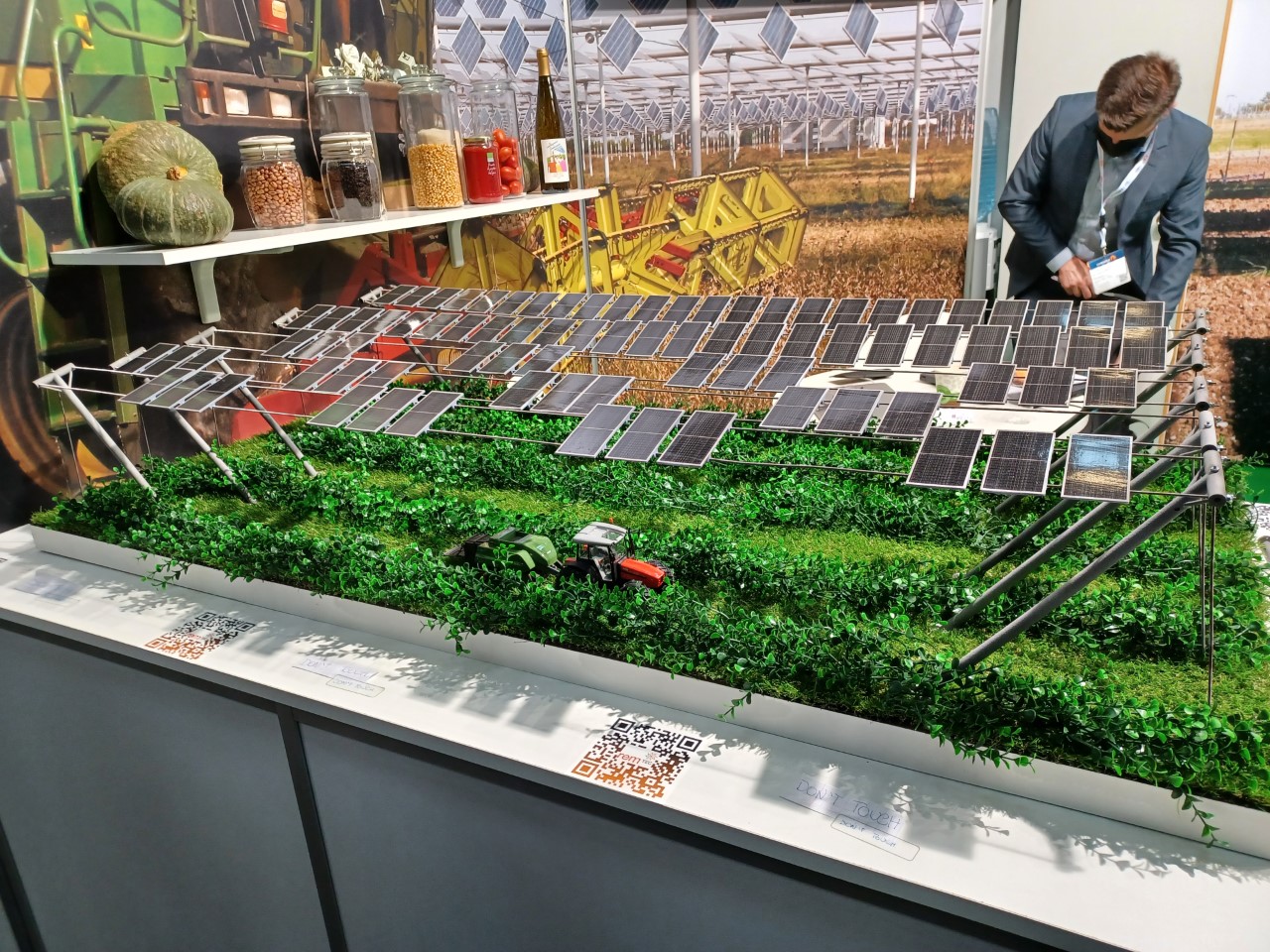
Agrivoltaic wine anyone?
Roberta Falato, an agronomist with Remtec, told pv magazine that it produced its (and one of the world's) first agrivoltaic wines. The grape, Trebbiano Toscano, is one of the most cultivated of all Italian varietals, and unlike some Italian grapes, which prefer cooler northern climes, the Trebbiano Toscano is grown mostly in central Italy and likes sunlight just as much as solar panels.
One of the perks of being at Intersolar 2021 is that we got to taste the wine too. Though young, the “Vitivoltaico Cuvée Silvaana 2020” is well-balanced (hence cuvée) with soft acids tempered by notes of candy and dried berries on the nose.
As an agronomist, Falato works with Remtec to design agrivoltaic layouts to optimize light and shading of particular crops, from pumpkin to alfalfa, and of course, wine. The Series 3 fixed, raised agrivoltaic system (model pictured) is set for its first construction project in 2022 in France.
This fixed solution with a rope tensioning method reduces costs and, with a length of up to 50 meters between two posts, it has an enormous span. The difficult thing at the moment is the rising steel prices, which are driving investment costs, said CEO Ronald Knoche. Apparently, this does not detract from the interest in his new offer. “I haven't had a free minute all day,” he laughs.
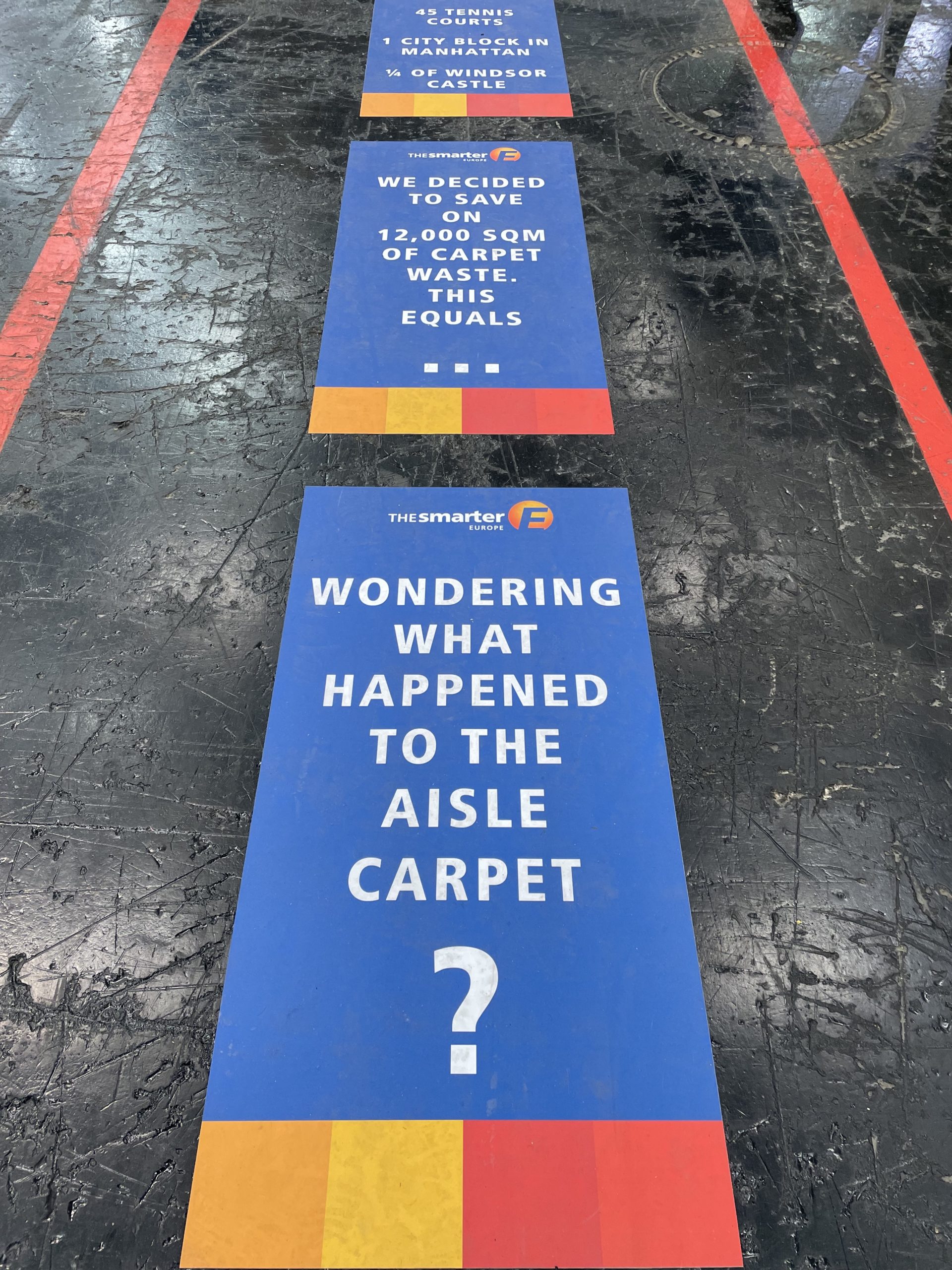
Polished concrete for sustainability
It can be a designer material for chic homes, but it’s also the sustainable product of choice for the Intersolar floor in 2021: polished concrete.
Doing away with the carpet, The smarter E organizers have no doubt saved a few euros, but they’ve also cut back of 12,000m2 waste – with no need to throw away the carpet at the end of each event.
The new-look also provided module cleaning provider Solarcleano with a chance to show off their polishing skills.
Visit us at Intersolar!
[TRADESHOW]
👟Follow us as we pass by @Intersolar´s many booths!
📍Pop by ours if you are around, we are waiting for you at booth A6.540!
📝Also, have a look at our live blog and do not miss a thing: https://t.co/WXstiUIvot#pvmagazine #intersolar21 pic.twitter.com/veTerYxctr
— pv magazine (@pvmagazine) October 6, 2021
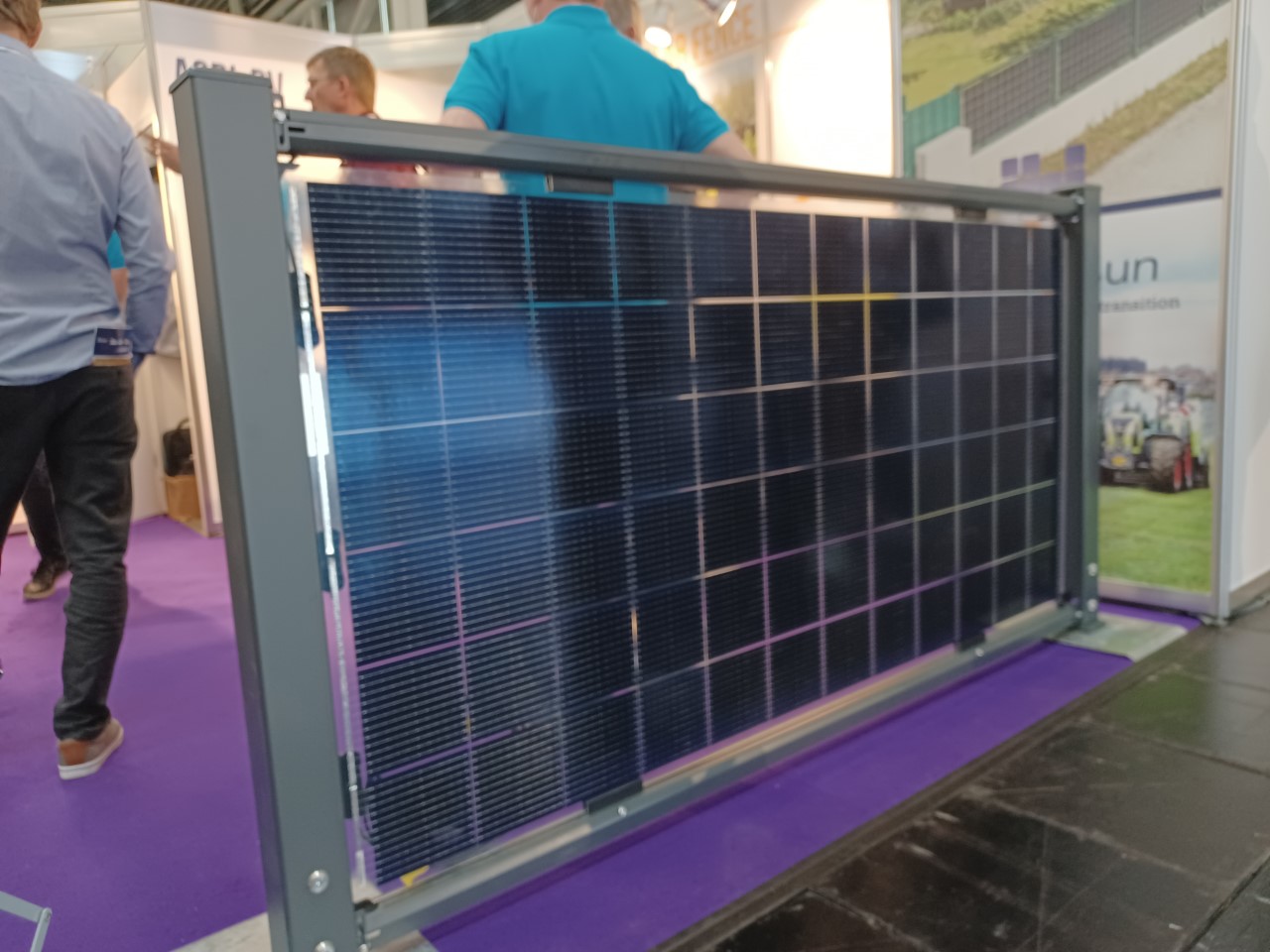
Taking a stab at solar fencing
When we think of building-integrated photovoltaics (BIPV), we don't often consider the blank borders we put up everywhere called fences. Next2Sun's CFO Sascha Krause-Tünker told pv magazine that its BIPV fences were introduced in 2019 but are now starting to scale. Perhaps the American poet Robert Frost was being ironic in his poem “Mending Walls” when he said, “Good fences make good neighbors”, but now, thanks to solar, there is such a thing as a good fence.
Next2Sun also has a fast-growing vertical bifacial agri-PV solution which Krause-Tünker says is receiving increasing interest from farmers, “especially in the north and east of Germany after hard, dry years. Farmers are very interested in Agri-PV as a way to go on farming with a supplementary income from solar,” he said.
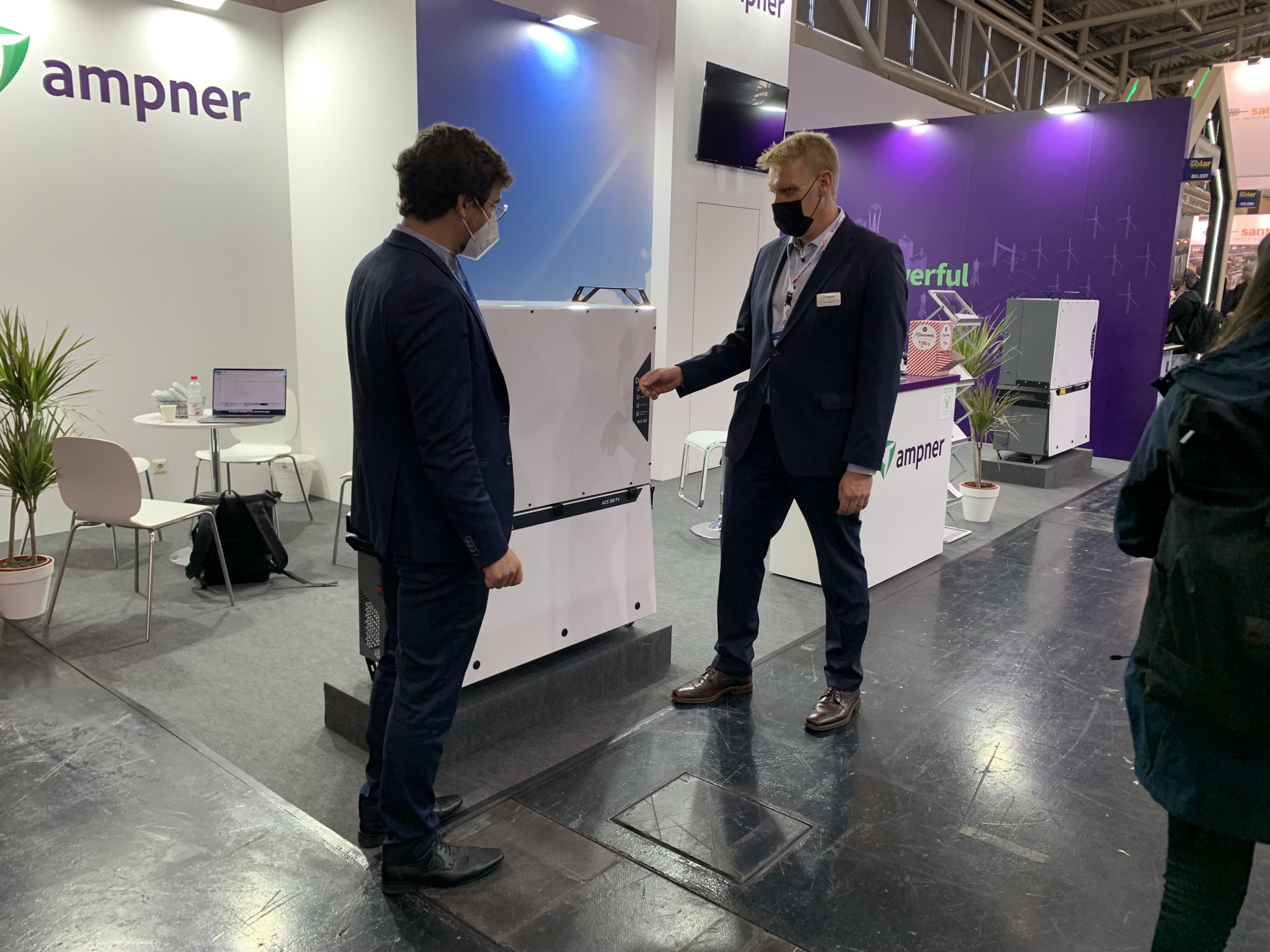
Finnish PV inverter traditions
When speaking about European manufacturing, PV module lines are what many have in mind. In Finland though, a new company called Ampner has stepped up to a great ancient Finnish tradition: PV inverter manufacturing.
Co-founder and CEO Mika Jantunen says that in the city of Vaasa, where Ampner is based, electrical engineering has always been a big source of employment, with dozens of companies active in the region. In fact, it was in Vaasa where ABB bought its share of Finnish electrical engineers back in the day. For the time being, Mika employs 50 traditional Finnish inverter makers who can assemble 1,000 inverters per month — or about 300-400 MW per year.
With the ACE 300 PV, the company has brought to the market a 300-kW string inverter, capable of handling 48 strings. “We wanted to have the biggest inverter,” Mika says of the large size of the machine. Standing up against stiff competition on a hard-fought market, Mika says that it helps that the Ampner team is not new to solar or inverters. For decades, they have been involved in the electrical engineering and integration of single components. “We can use our know-how from all these years.”
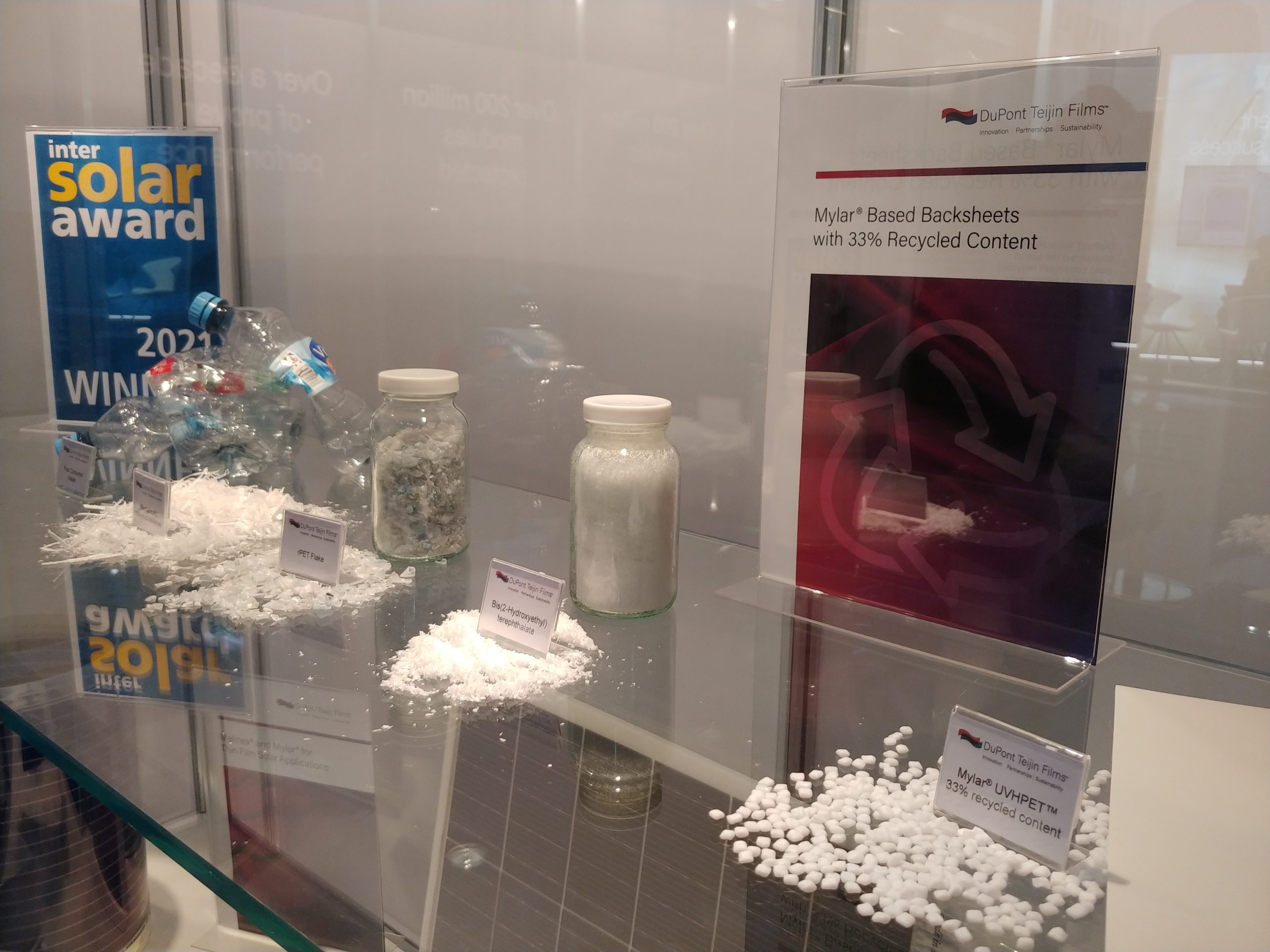
For recycling, recovery comes first
We met with Steven Davies, market manager for DuPont Teijin Films – which is exhibiting its Mylar material for PV backsheets at the show. He says that while they can already produce the material using a high proportion of polyethylene terephthalate (PET) recovered from plastic drinks bottles and other consumer goods, establishing a ‘closed loop’ recycling model for PV modules depends on developing processes to separate the valuable materials from the products at end-of-life.
DuPont Teijin is exhibiting old backsheet materials, shredded and ready to reenter production, at its booth – part of a collaboration with Italian backsheet producer Coveme. Davies told us, however, that this process is not currently cost-effective to operate at large-scale, and that at current levels even recycled PET is more expensive to integrate in production than new materials. And though waste modules are already piling up, we are still years away from the volumes that will allow for development of processes at large scale.
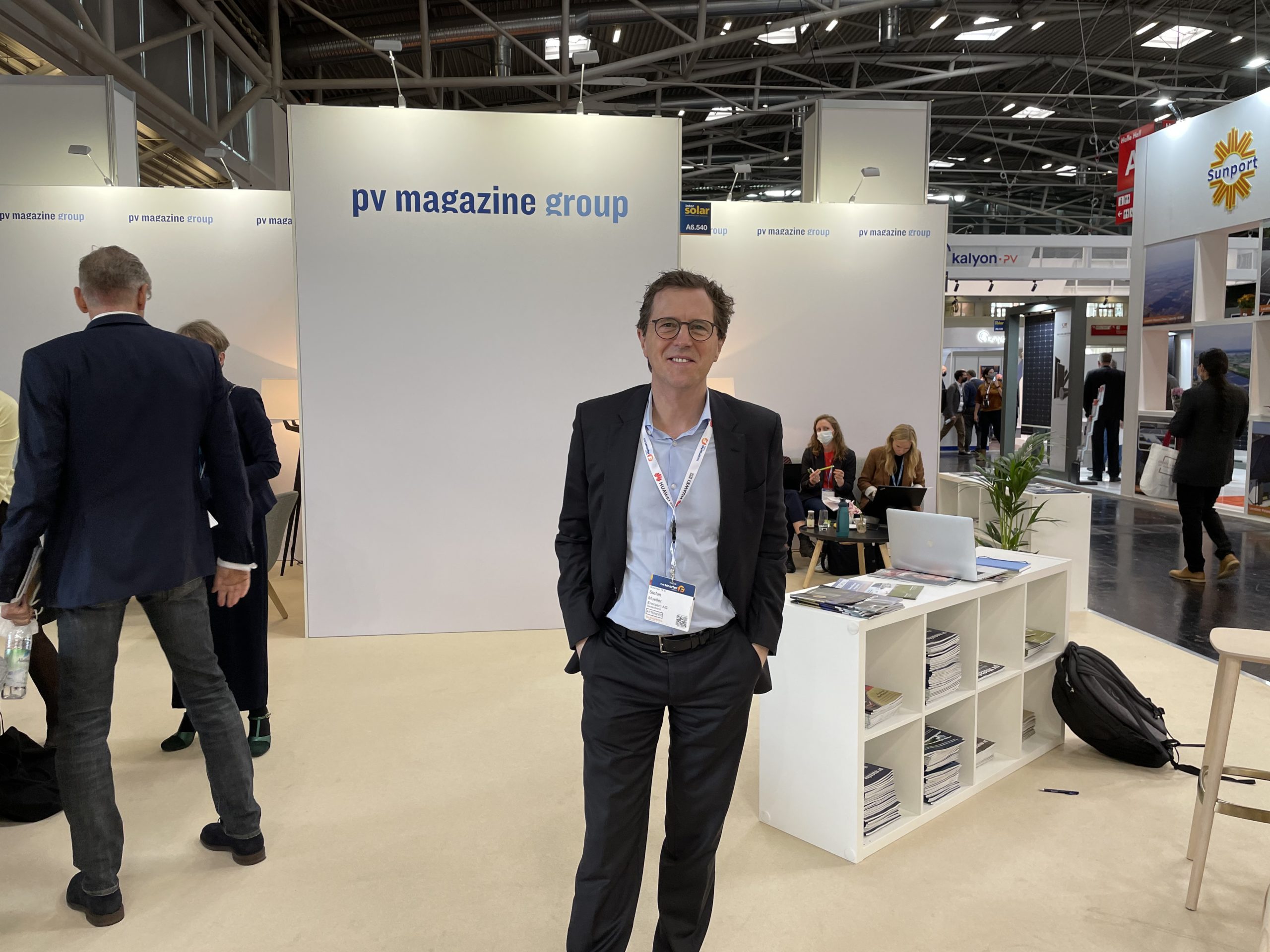
More concerns voiced over PV module prices, project delays
Stefan Müller, COO of Enerparc AG, one of the largest German EPC and solar investment companies passed by the pv magazine booth earlier. Having talked with large PV module suppliers at the show, he is concerned about the supply situation and rising module prices – like Everoze (see earlier blog post) and PVO International. Nevertheless, Enerparc has thus far been able to buy enough modules.
The company calculates an average module price for the year, and it purchased a large batch at the beginning of 2021 for a very good price, meaning it can now afford to buy a batch at the current higher prices.
However, Müller says that medium and smaller companies are experiencing problems. Recently, he says Enerparc has been approached by developers looking to give their projects to Enerparc for free, because in Germany you must pay a fine if you do not finish tender projects within the agreed upon timeframe. It would be good if the federal network agency, Bundesnetzagentur, would allow for some flexibility for the realisation dates.
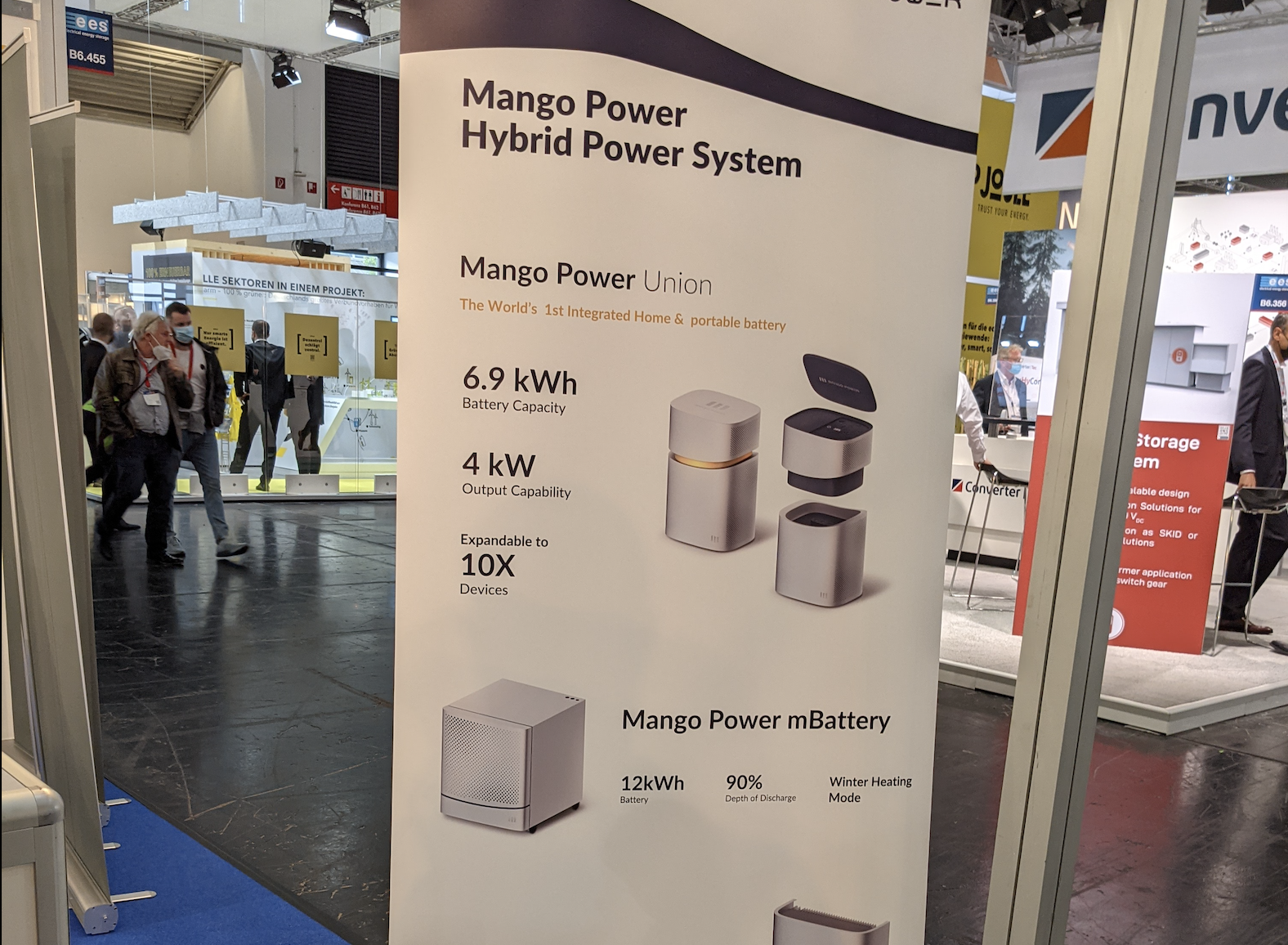
Residential-friendly energy storage
Residential friendly energy storage is an evolving and exciting field. While no one at Intersolar has yet found a way to reduce size and weight, innovations are coming. pv magazine stopped by Hall B to chat with Chinese startup Mango Power, which is bringing portability to the home storage equation.
Linyue Dong showed a prototype of the Mango Power Union, a 6.9kWh hybrid battery power system. Able to be charged from renewable energy sources or from the grid, the unique advantage of the product is its portability: its top section is completely detachable, and features an array of ports and plugs, including wireless and car output, to power anything from homes to phones.
The top section houses a 2.3kWh polymer NCM battery cell, and it can provide UPS support, and features Smart Control via Bluetooth and Wi-Fi.
Mango Power calls it a world-first and will be shipping the device in China and Europe within “one to two months.” Its RRP starts at €6,000, with volume discounts possible. Weight may be an issue: the package weighs 68 kg, with the top section 20 kg.
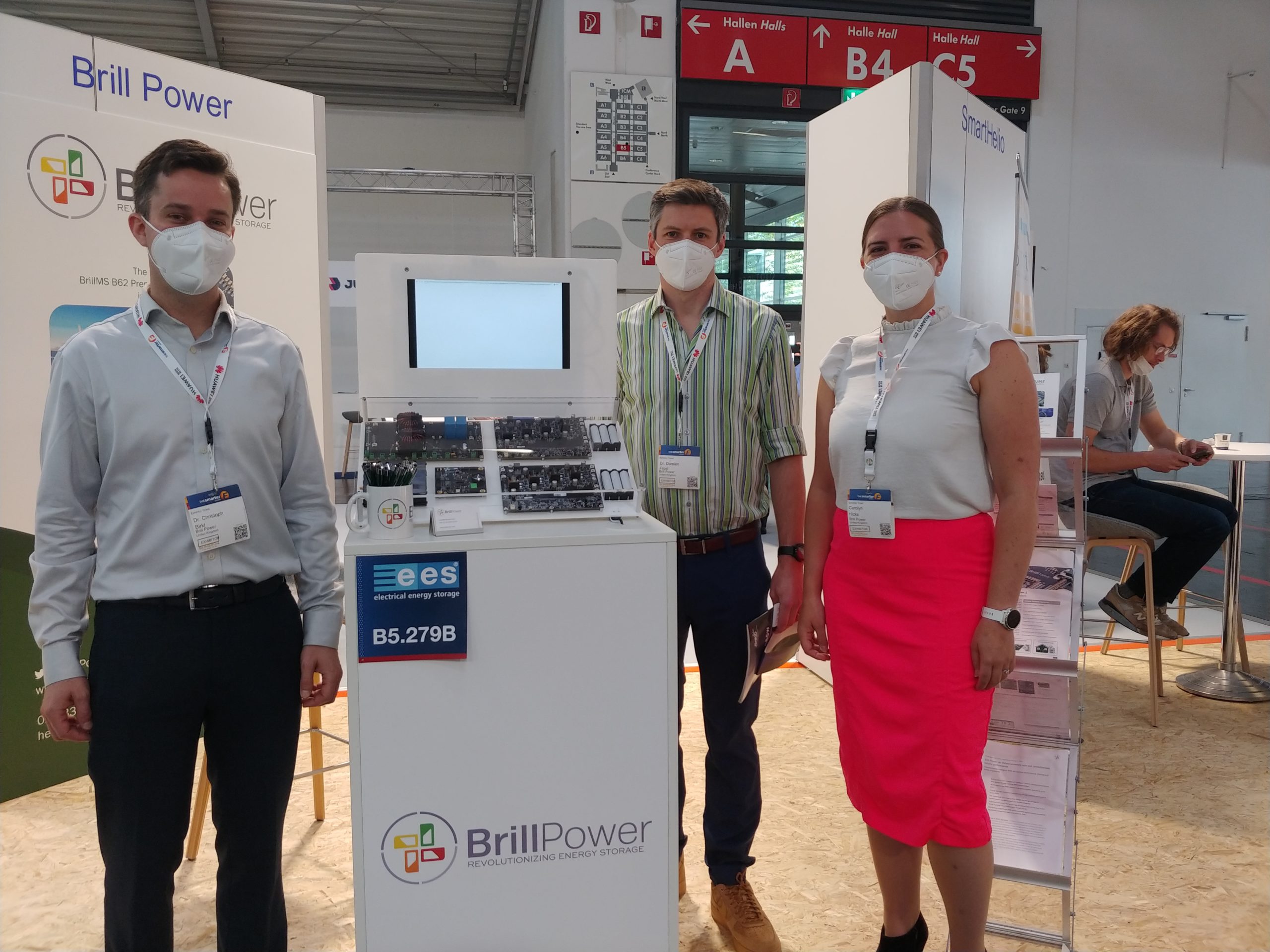
Startup Brill Power promises extended battery lifetimes
As always there are plenty of new technology offerings on show at Intersolar, and not only from the big players you’d expect to see. pv magazine stopped by the startups section in Hall B to meet with Brill Power, a U.K.-based startup promising to extend battery lifetimes through careful management of flow through the battery, down to the cell and module level.
The battery management system promises up to a 60% lifetime extension for all lithium-ion battery chemistries, as well increased safety by managing energy flows through individual cells and modules, and even bringing the possibility of isolating parts of the battery that are causing problems.
Brill says it is already working with battery manufacturers and integrators to add the circuit boards that contain its management solution to battery packs in manufacturing. And CEO Christoph Birkl tells us that one of his aims with this solution is to allow battery manufacturers to offer longer performance warranties.
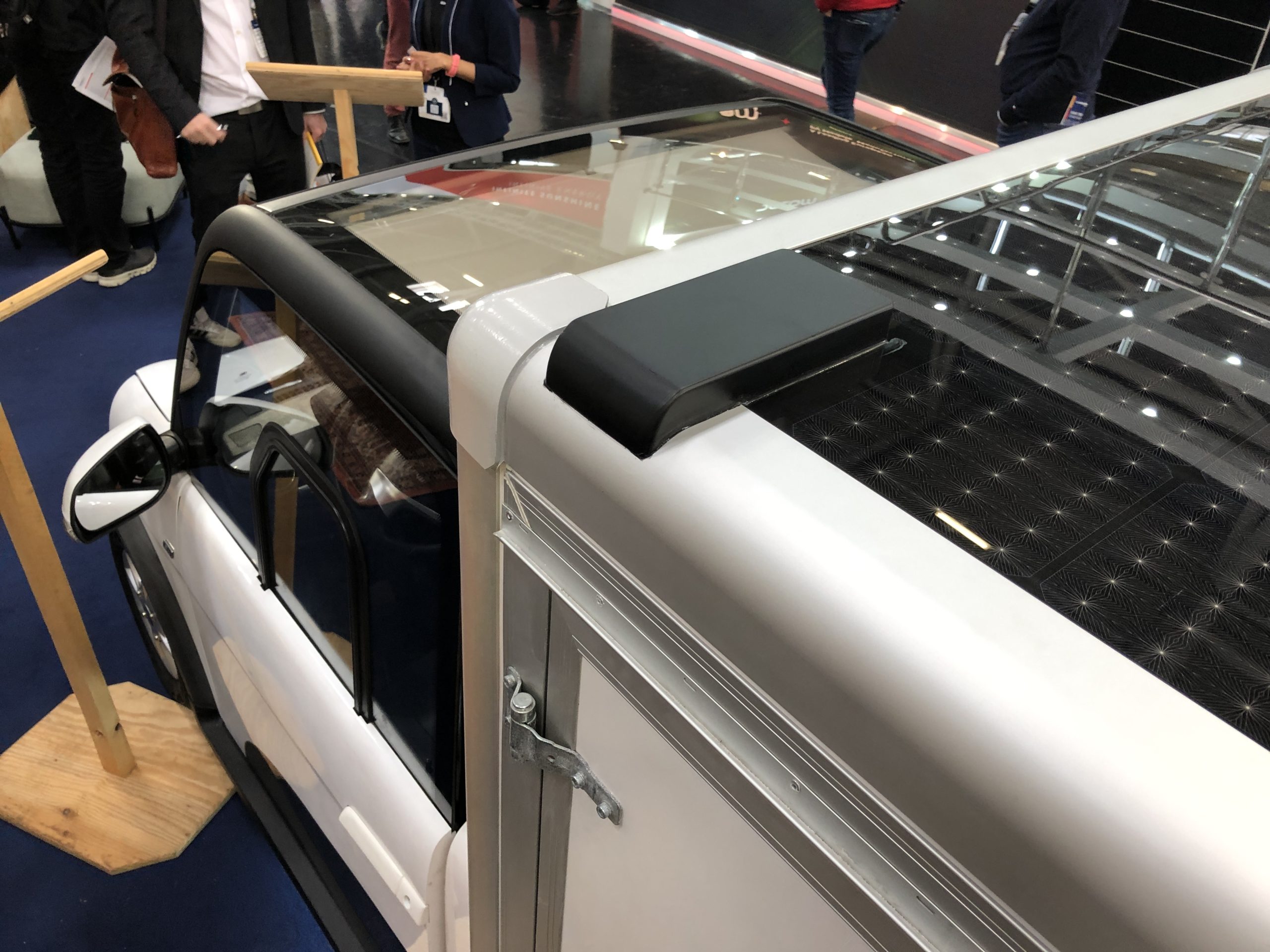
Self-charging cars
Many operators of large vehicle fleets have no idea how much electricity their bus or truck consumes. It is, however, reflected in their diesel consumption. “For a bus with air conditioning, entertainment, and WiFi, it can be several liters per 100 kilometers,” reports Mathieu Baudrit, Group Lead at Sono Solar.
The company is known for developing the Sion, a car with solar cells integrated all around the body. While the series production of the electric car is still a long way off, Sono is embarking on a completely new business area – solar integration in existing vehicles, be it EV or conventional. The first customers include MAN and Ari Motor.
The prototype for a small delivery vehicle has been ready since Monday and can be seen here at Intersolar Europe. It is supposed to take over deliveries on the last mile in a fully electric manner and must be plugged in even less often. We will shortly report more about the savings that can be made and how you can solarize your fleet.
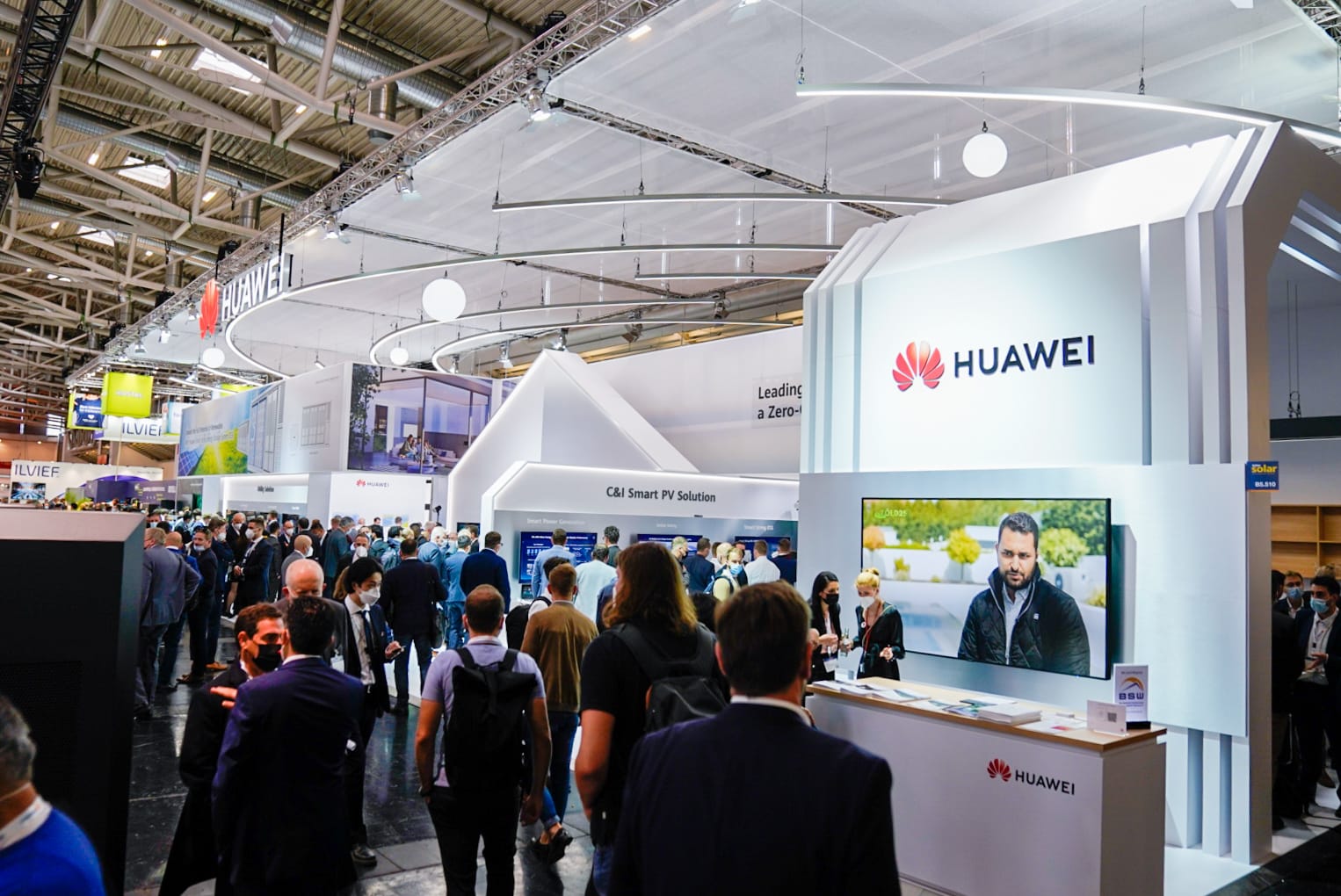
Huawei unveils new products
The Huawei team tells pv magazine it is excited to be back at Intersolar Europe! This year, it is presenting its latest FusionSolar All-Scenario PV & Storage solution, which unlocks the advantages of ‘smart string’ design, intelligence, modularity, multi-MPPT, high protection, among others, and comprehensively reinvents the power electronics architecture.
Visit booth B5.510 to find out more!
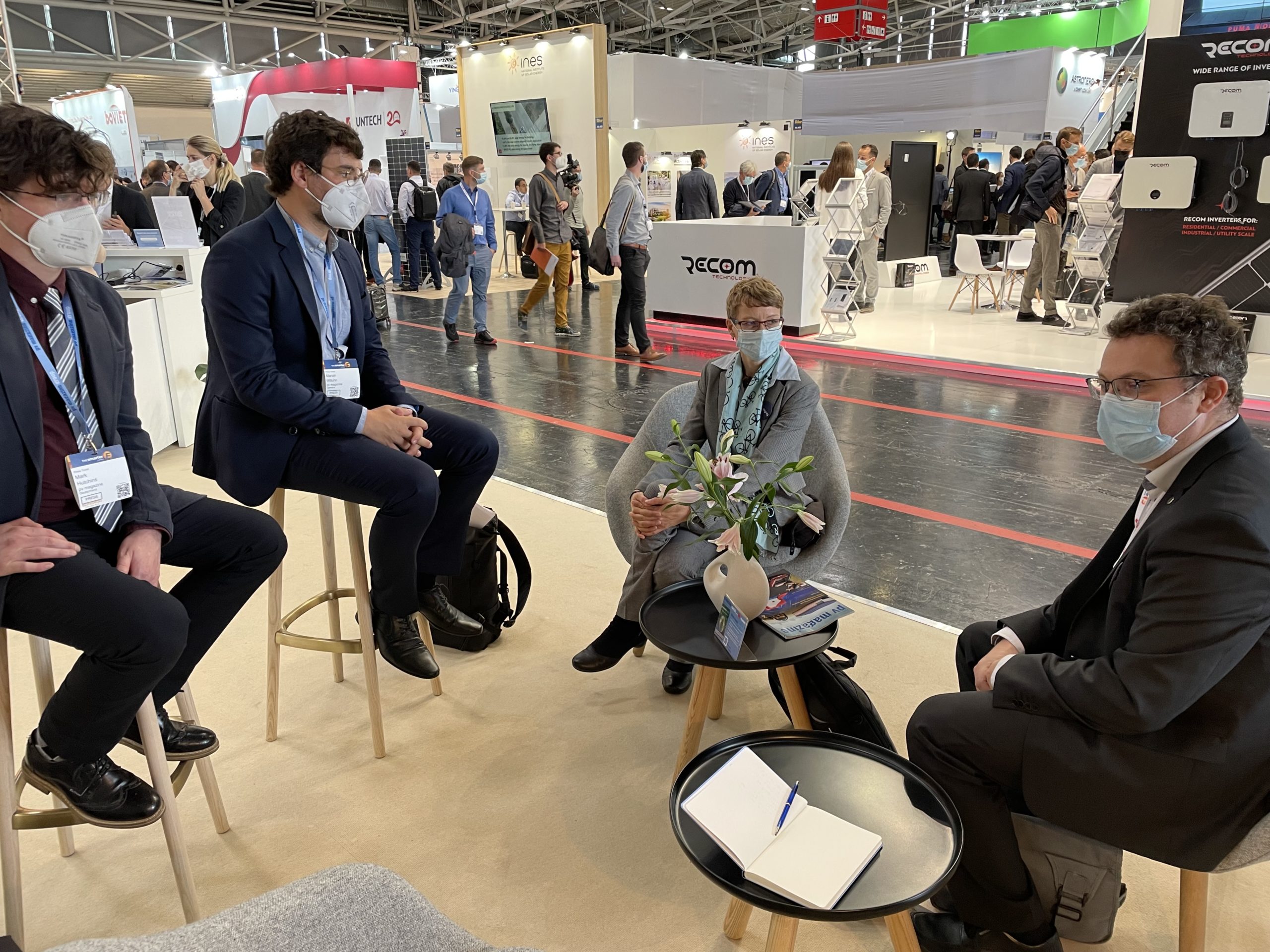
Everoze warns of project delays gripping Europe
While it’s clear there are big crowds and an upbeat mood at Intersolar Europe’s return, constraints are one of the big talking points – and are likely going to depress installations throughout Europe in 2021.
European engineering consultancy Everoze stopped by the pv magazine booth and reported that tight supply and rising prices are holding some PV projects and causing others to be put on ice.
Everoze partner Ragna Schmidt-Haupt said that some developers with whom she is working are finding that supply delays in PV modules and batteries are causing projects to be paused, and even impacting whether some PV power plants can be built at all, particularly when they have bid low prices for tenders or signed low PPAs.
“We are now discussing now whether to increase the risk in the Technical Due Diligence reports because of uncertainty of supply,” said Schmidt-Haupt. “Even for mounting structures,” added fellow Everoze partner Nicolas Chouleur.
Modules prices in Europe are increasing, as they are all over the world, with Everoze confirming they are seeing prices quoted up to €0.25/W. “It is something we haven’t seen for a long time,” said Chouleur. “The question is whether it will return [to low prices seen in 2020].” All-in EPC project prices have returned to around €1/W, the Everoze team reported.
This ties into the story we published this morning from pv magazine Germany, where PVO International said PV modules are currently trading at price levels last seen in 2018 and 2019. EPC companies in Europe, in particular, are suffering, while a lack of large-scale integrated PV production on the continent is also playing a role.
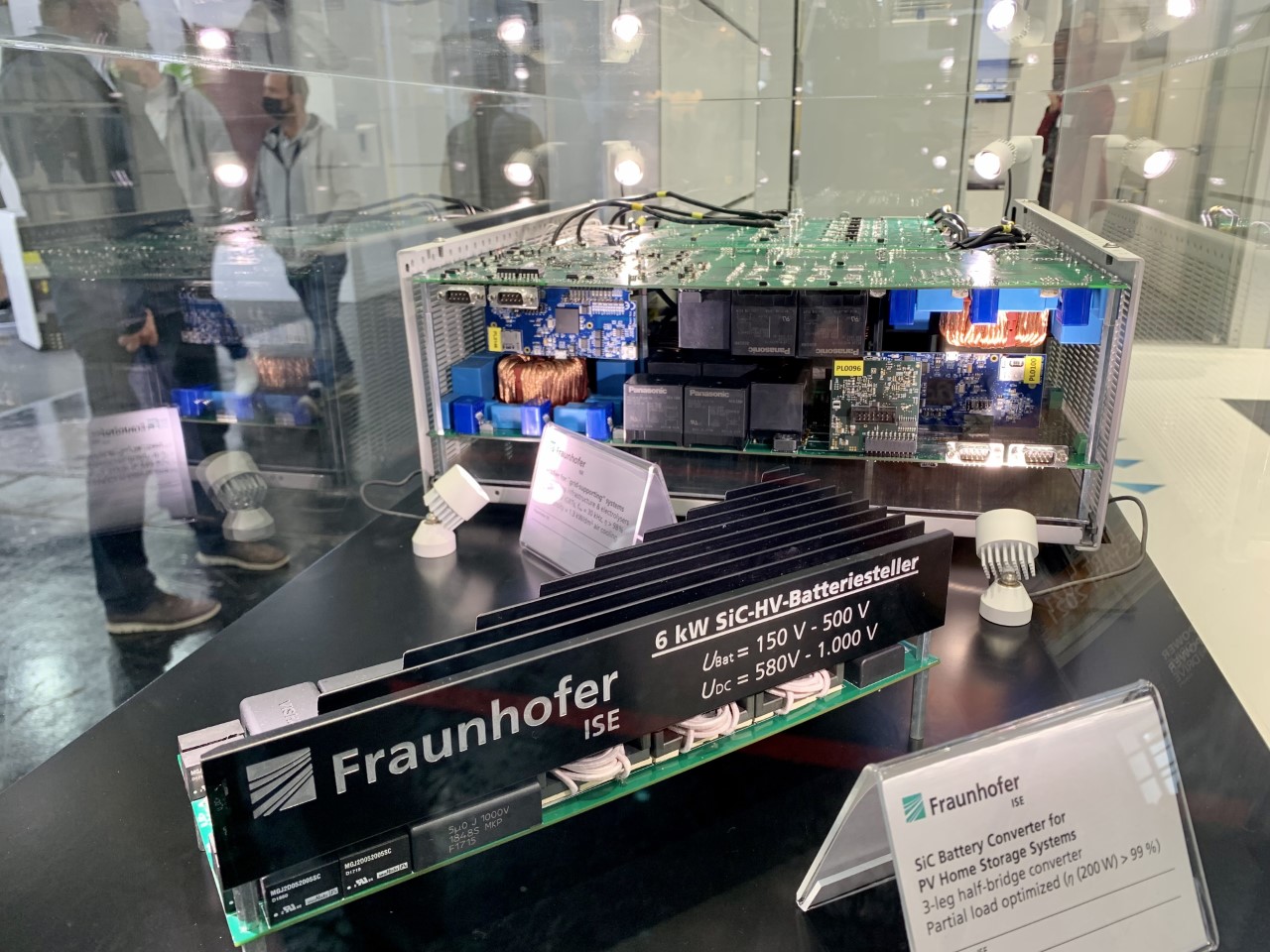
Maximum efficiency at lower loads
The efficiency ratings of modern power electronics routinely achieve 98% and higher but that maximum level is only relevant when running on a full load, and inverters are hardly ever going at full throttle.
pv magazine‘s Marian Willuhn has found this device at Intersolar, though, by researchers at the Fraunhofer institute.
Thanks to silicon-carbide MOSFETs and intelligent steering of the switches, this 6 kW battery inverter module is said to achieve maximum efficiency of 99% – at just 200 W of load.
In the back, there is a 40 kW inverter to create DC from grid power and the device’s smart and active controls prevent it from having any effect on the grid. After all, if 20 GW worth of electrolyzers and EV chargers were to turn AC into DC without proper control algorithms, grid operators would become very nervous.
Prepare for a delayed entrance, folks
We've had our first grumpy update of the day, with pv magazine chief Jonathan Gifford noting there are bigger delays than usual at the entrance to an event which has been tagged ‘Intersolar Restart.'
The gaffer suspects Covid testing is playing its part but also noted there seem to be fewer staff at the entrance than in previous years.
Anyhoo, those of you yet to to arrive should prepare yourselves accordingly and, in case you haven't been reading this blog religiously up to now, you should also note that this year, the show entrance is at the eastern end of the site, at the Messestadt Ost tube stop.
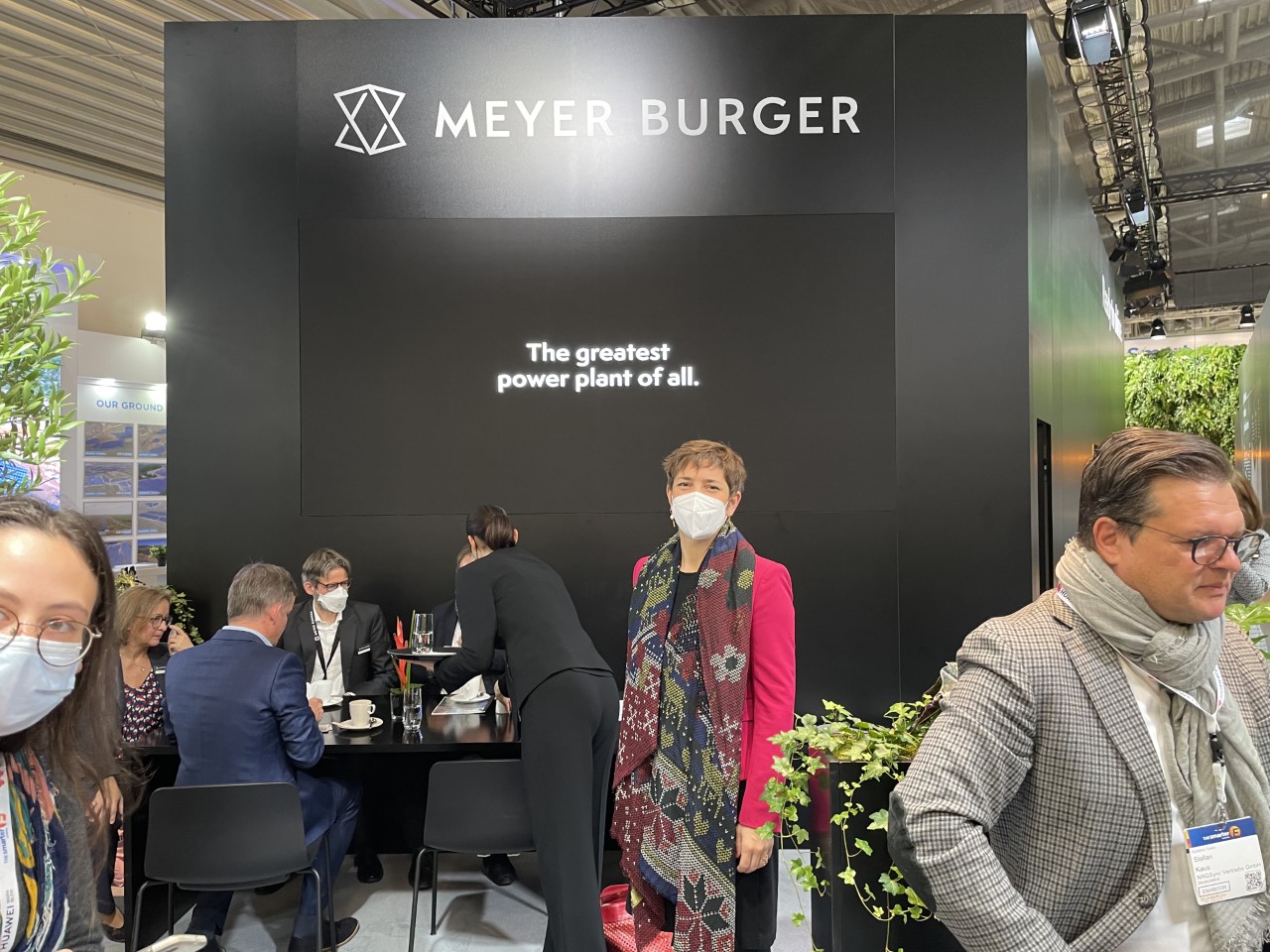
We've been celebrity spotting already!
That's Walburga Hemetsberger, chief executive of trade body SolarPower Europe dropping in to the Meyer Burger booth.
With ‘made in Europe' solar cells and modules a hot topic at this year's show, Walburga (we're on first-name terms, you see) told pv magazine‘s Michael Fuhs she is looking forward to development in the continent's solar manufacturing industry.
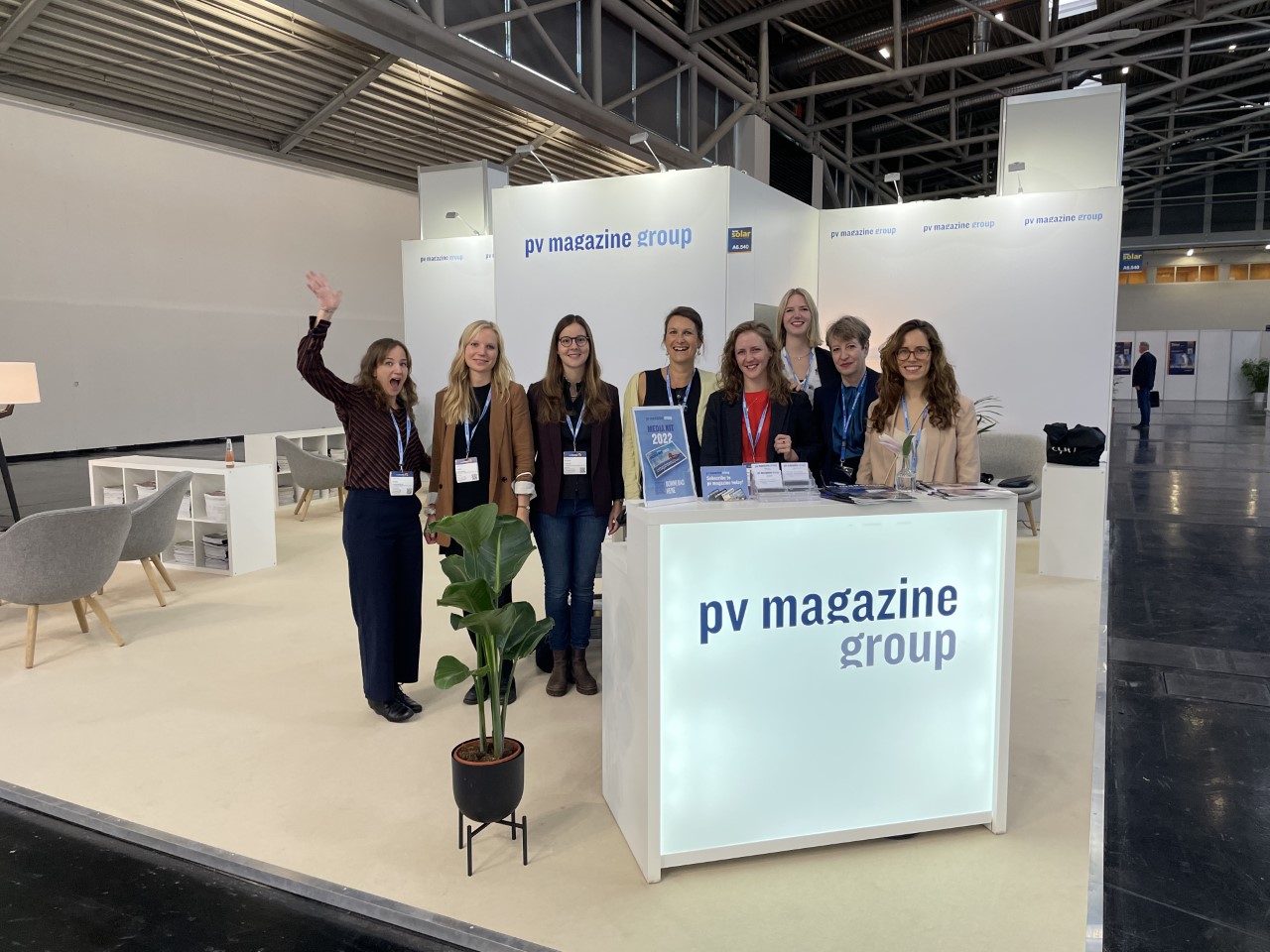
Come and meet the team!
Come along and say hello to the pv magazine crew at our booth, we've missed y'all!
To find us, turn left after entering the show at Messestadt Ost, into hall A6, then hang a right and you'll find us near the Meyer Burger and Trina Solar booths, at a6.540, for those of you familiar with the Intersolar location jargon.
Our head of marketing Marina Ramain (that's Marina on the right, there) will be waiting to say hello and, if you're lucky, we might even get the kettle on.
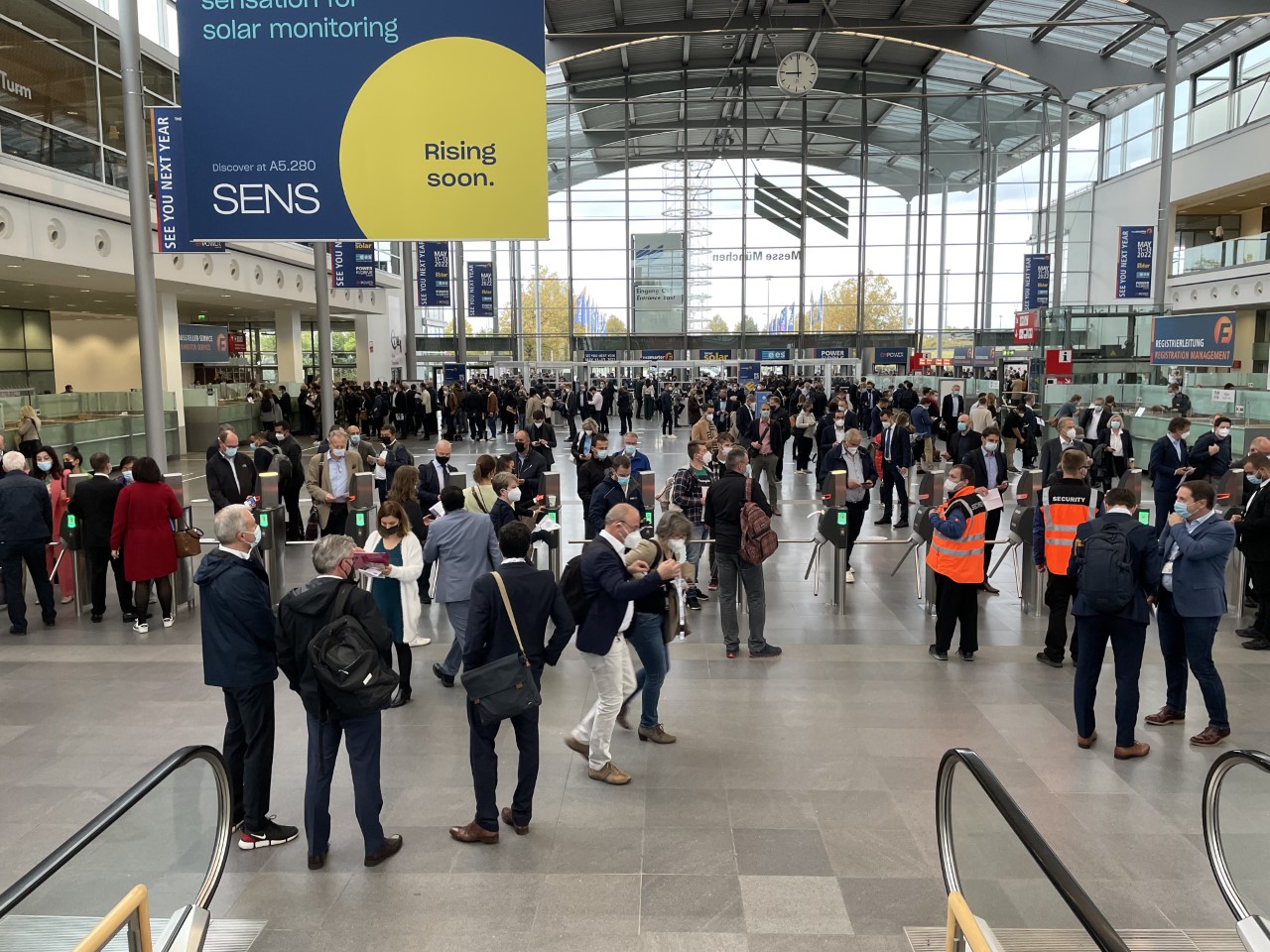
The buzz is building at Messestadt Ost
Here's a shot of the queues starting to form near the Messestadt Ost stop on the Munich metro which leads to the entrance to this year's Intersolar Europe trade show.
Exhibitors have already setting up for what promises to be a dynamic return of the event, with residential and commercial electric vehicle charging among the hot topics for discussion at the return of Intersolar.
Welcome
The editorial team will be scouring the halls and meeting with the established market leaders, the new kids on the block, and the industry’s leading analysts to bring you the latest PV and energy storage news from the ground.
In addition to reporting on the latest PV product launches, we’ll be looking to find out more about the most pertinent solar issues, like supply chain disruption, PV module prices, carbon pricing, European manufacturing, and the state of hydrogen, among many other issues.
Send your impressions of Intersolar Europe to liveblog@pv-magazine.com. We'll try to feature as many of your comments here too!

